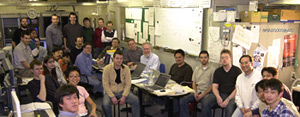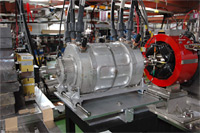 |
|||||||||||
|
|||||||||||
|
|||||||||||
|
Last November, a team of accelerator physicists from KEK and SLAC succeeded in extracting three bunches of electron beam each spaced by 154 nanoseconds from the storage ring in the Accelerator Test Facility (ATF) in Japan. (See ILC NewsLine, 10 November 2005) Using a "kicker magnet" with a pulse length of 310 nanoseconds, developed by SLAC, this important accomplishment delivered an ILC-like beam for the first time. Transporting bunches of electrons and positrons to the main linac, the damping rings play a crucial role in maximizing the number of collisions in the ILC. By giving the electrons pulses of energy – or literally a "kick" -- the kicker magnets move the bunches in out of the ring. The ATF complex uses a "double kicker system." A stabilization system, the double kickers counteract any jitters in the pulser system, resulting in a very smooth extracted beam. From injection systems to most recently kicker magnets, SLAC and KEK have partnered together for more than ten years now on projects at the ATF. "KEK has a very unique beam facility.", said Marc Ross, a physicist at SLAC who plays a lead role in the collaborative projects with KEK. "It is the most mature and expensive linear collider test beam facility out there." Following the ITRP decision to use cold superconducting technology for the International Linear Collider, KEK needed a different extraction system for the ATF. In order to replace it, they required a new kicker system, which is where SLAC stepped in. "We got refurbished equipment that was used at SLAC more than ten years ago.", Ross said. "Together with the Japanese crew over a period of eight months, we cleaned up the system, tested it at SLAC and shipped it over to KEK." While getting the new kicker system installed and functioning was a major feat, just packing up the equipment was a very large task in itself. "All of the furniture of a small house could have been packed into the 15 boxes that we sent over.", Ross said. "It was a lot of work for everyone at SLAC." SLAC even recruited the help of five summer students to coil 693 feet of RG220 coaxial cable inside an 8' x 8' wood crate, which was specially designed for the project. Weighing in at 700 pounds, the cable provides the Pulse Forming Lines (PFL) in the kicker system at KEK. The duration of each pulse in the kicker system depends on the PFL's length. Now installed in the ATF, the cables remain coiled in their wooden casing and send electric pulses into the kickers, leading to the recent achievements between KEK and SLAC. Ross explains that the collaboration between KEK and SLAC is very beneficial for everyone involved. Because members of the SLAC team will often spend several weeks at a time at KEK, they truly immerse themselves in the culture and rent a Japanese-style home. "It really makes the best of both worlds.", he said. "You get an idea of how things work differently in other laboratories. From a technical standpoint, the partnership is very successful, especially with the cementing of the ILC. I'm also very pleased with SLAC's strong support of this partnership. They are sending some of their top people, and it's paying off." -- Elizabeth Clements |
|||||||||||
| © International Linear Collider |

